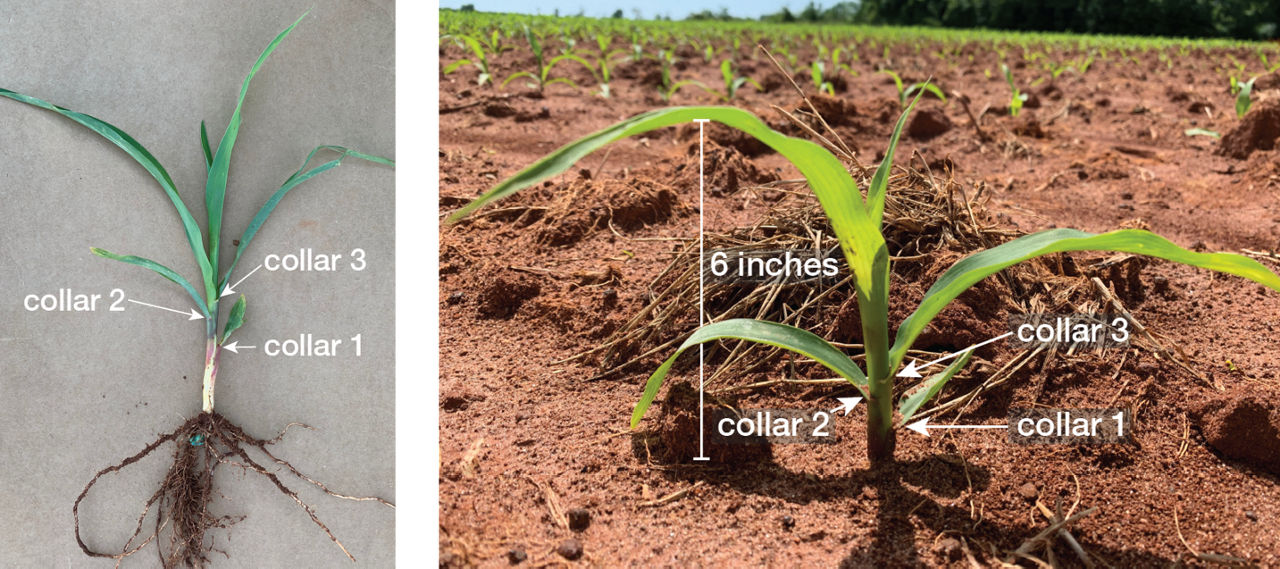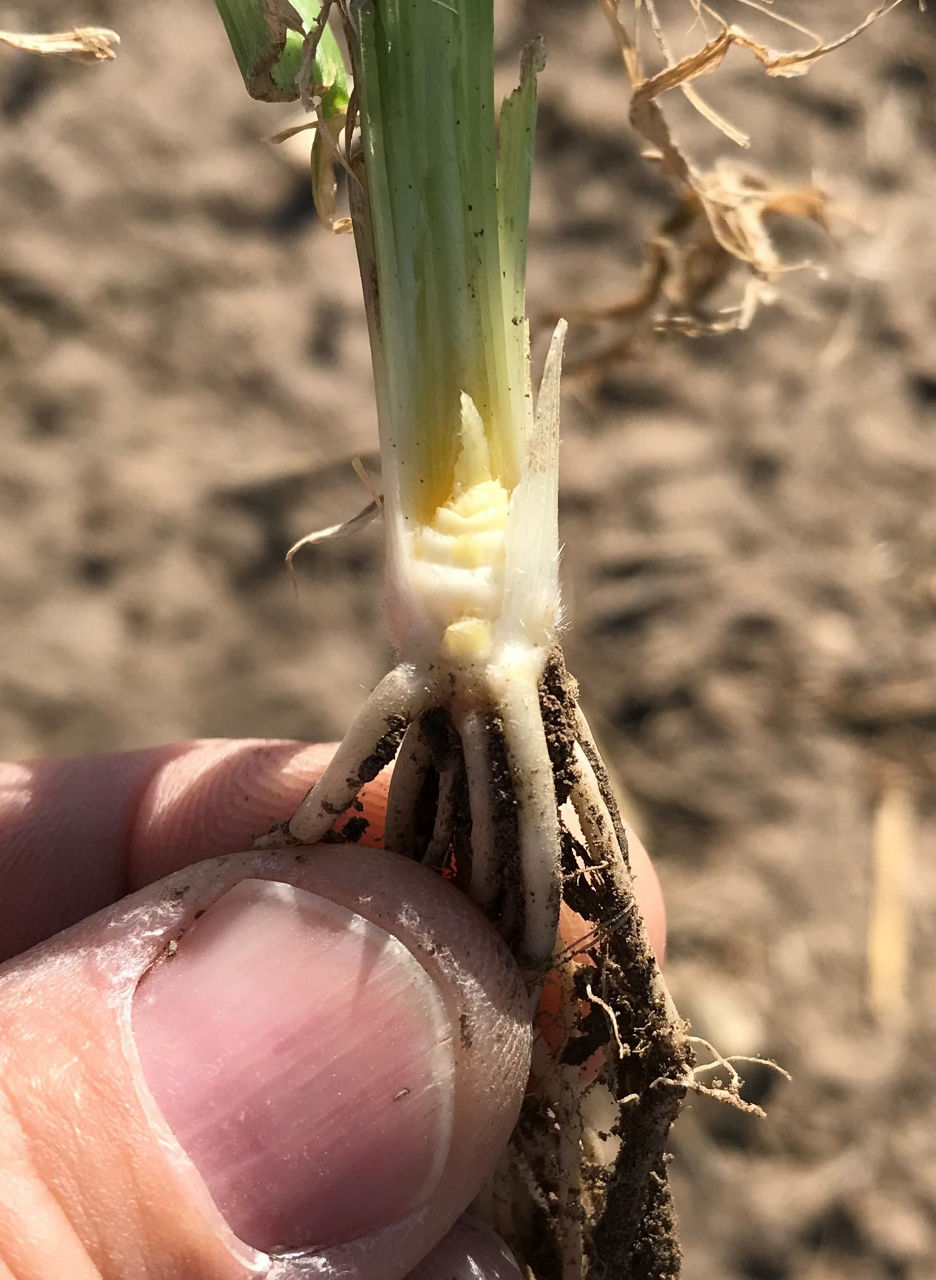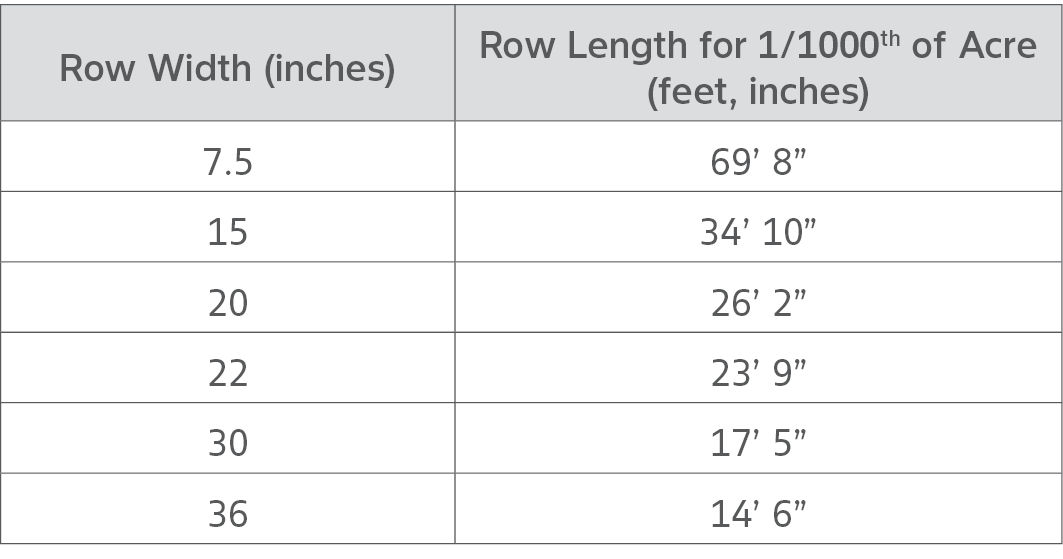Corn Replanting Process for Southern United States
April 24, 2024
- Deciding to replant corn, whether due to a failed stand after planting or stand loss after a storm can be a difficult decision.
- The first step is to assess the quality of the stand and estimate the yield potential of the crop. This can only be accomplished by determining the growth stage, number of living plants, and if the stand loss was caused by a storm the amount of leaf damage.
- Replant cost including seed, labor, tillage, and chemistry should be considered.
Determine the Growth Stage
Corn growth stages before tassel emergence are determined by the number of leaves on the plant. The first leaf to emerge is the coleoptile (spike) and signifies emergence or VE growth stage. When the coleoptile leaf expands, it has a rounded tip and is considered vegetative emergence or V1 when its collar is fully exposed (Figure 1). Future vegetative stages are based on the coleoptile leaf and should be accounted for regardless of its disappearance. Leaf stages are only counted when the leaf collar is visible (Figure 1). Once the tassel emerges from the topmost leaf whorl (the VT stage) corn enters the reproductive stages. Stage R1 refers to the emergence of silks from the ear.

When examining a corn plant during vegetative growth with considerable leaf loss, the stage of development can be determined by splitting the lower stalk lengthwise and counting the internodes. Starting at the bottom of the stalk are four compressed nodes that are hard to distinguish from one another; however, the node clearly visible after the compressed nodes is the fifth leaf node. The vegetative stage can be determined by using this node as a reference point and counting the number of elongated internodes above this fifth leaf. The node corresponds to the leaf count, so the fifth node is the fifth leaf and so on. For more information on corn growth stages please see Determining Corn Growth Stages.
Determine the Damaged Plants
After emergence failure or a damaging event, the number of viable plants should be determined. With failure to germinate, emerged, viable plants should be counted. If the plants are damaged by hail, herbicide, or other injury, the health of the growing point should be determined by splitting the stem down the center, to expose the growing point (Figure 2).

Prior to V4 to V5, the growing point is below the soil surface and appears as a mass of dense tissue at the base of the plant. By V6 the growing point can be found about 1 to 1.5 inches above the soil surface and appears to be a dome shaped area of dense tissue (Figure 2). From V8 to tassel (VT), the growing point can be found above the elongating internodes. By VT, the growing point has differentiated into the tassel. A healthy growing point should appear light green to whitish. When a growing point dies it appears watery, soft, and brownish and as such, the plant should be considered as non-viable. However, if the injury is above the growing point, the plant can survive and should be considered viable.
If the damage is related to hail or wind whip, it may result in the dead leaves interfering with normal leaf emergence. In most cases, the plant can “push” through this type of injury, but if the new leaves roll into a tight “buggy-whip” they should be considered non-viable as well.
Determine the Population
In several, random field locations, measure the length of row necessary to represent 1/1000th of an acre, count the viable plants within that distance, and multiply by one thousand to obtain the viable plants per acre (Table 1). (As an example, 23 plants in 17 feet, 5 inches for a 30-inch row = 23,000 plants/acre)
Table 1. Row length to measure for 1/1000th of an acre.

Determine Yield Potential
Information from North Carolina State University suggests a remaining plant population greater than 20,000 to 22,000 plants per acre is still has an opportunity for a profitable yield potential.1 If the remaining plant population is between 18,000 and 20,000 plants per acre, replanting should be carefully considered. A yield reduction of about 10% is possible when the plant population is between 18,000 and 20,000 plants per acre on soils with a realistic yield expectation of over 130 bushels per acre. On soils where the yield expectation is below 130 bushels per acre, there is still an opportunity for corn yields to reach that level.
When the plant population is below 18,000 plants per acre and there is calendar time to plant an alternative crop with a good chance of normal yield potential, then replanting should be considered. A corn crop with less than 18,000 plants per acre is unlikely to yield over one hundred bushels per acre under normal conditions. Yield reductions of 25 to 40% are common when the plant population is less than 18,000 plants per acre.
Determine Yield Potential Due to Leaf Loss
In addition to lost plants, leaf loss on the plants that survive should be considered. Table 2 lists the effect of various amounts of leaf loss on yield potential at different growth stages. Note that leaf loss has less effect on yield potential when it occurs either early or late in the growth of the corn plant. Leaf loss estimates should be taken in several random areas of the field. For additional information, please visit Mid-Season Hail-Damaged Corn.
Table 2. Percent of potential corn yield loss by percent of leaf loss at several corn growth stages.*

Determine if Replanting is Necessary
To determine if replanting is necessary, a realistic yield potential without injury should be determined. After the realistic yield is determined, multiply it by the percent yield reduction expected from the remaining plants.
For example, the final potential yield estimate for a V10 growth stage stand with a realistic yield potential of 150 bu/acre, a remaining plant population of 19,000 plants/acre, and an expected 10% yield reduction (15 bu/acre) would be 135 bu/acre.
With plant injury, estimate the leaf damage, for this example it is 40% which equals 4% yield loss from Table 2.
The adjusted yield of 135 bu/acre x .04 = 5.4 bu/acre for a final yield estimate after damage to be 129.6 bu/acre.
Costs to replant, such as destroying the current crop, seed, seed bed preparation, and planting should be considered. In this example, it is unlikely this grower would gain profitability by replanting if the damage has occurred after May 10 (a likely date if the corn is at V10). In fact, it would take severe reductions in plant population and leaf area to justify replanting.
How soon should the decision to replant be made?
Patience is the key. Waiting at least three to five days after a storm provides a clearer picture of the extent of the damage. If replanting is being considered because of a first planting failure, a replanting delay is not really needed after a stand assessment.
If the field needs to be replanted, what is the first step?
Eliminating the remaining plants is the first step. Plants can be killed by tillage, herbicide, or mowing if the growing point is above the soil surface. If the corn is 4- to 8-inches tall, clethodim herbicide is a recommended option.2 However, if clethodim is used, replanting cannot occur until at least six days after application. If the field needs to be replanted prior to six days, an option is paraquat used in conjunction with atrazine and suggested adjuvants to enhance control.2
What relative maturity of corn should be used?
If replanting because of a failed initial planting, a corn product with the same relative maturity (RM) could be planted. If replanting later in the season as the result of a storm, the RM of the corn product depends on many variables and the geography. In North Carolina and Virginia, a corn product ranging in RM from 108 to 114 days should be considered when replanting in June as later maturing products do not show improved yield potential when planted in June and result in harvest delays.3
Sources
1Heiniger, R.W. 2017. Replant guidelines for corn. North Carolina State University. https://corn.ces.ncsu.edu/corn-production-information/replant-guidelines-for-corn/
2Cahoon, C. and Flessner, M. 2017. Failed corn stand: Starting over. Virginia Ag Pest and Crop Advisory. Virginia Cooperative Extension. Virginia Tech University. https://blogs.ext.vt.edu/ag-pest-advisory/failed-corn-stand-starting-over/
3Heiniger, R. 2017. Management for late planted corn. North Carolina State Cooperative Extension. https://corn.ces.ncsu.edu/corn-production-information/management-for-late-planted-corn/
4Corn loss adjustment standards handbook. FCIS-25080 (11-2023). United States Department of Agriculture (USDA) and Federal Crop Insurance Corporation (FCIC). https://www.rma.usda.gov/-/media/RMA/Handbooks/Loss-Adjustment-Standards---25000/Corn/2024-25080-Corn-Loss-Adjustment-Handbook.ashx
Web sources verified 3/27/24. 1110_383451
Seed Brands & Traits
Crop Protection
Disclaimer
Always read and follow pesticide label directions, insect resistance management requirements (where applicable), and grain marketing and all other stewardship practices.
©2024 Bayer Group. All rights reserved.